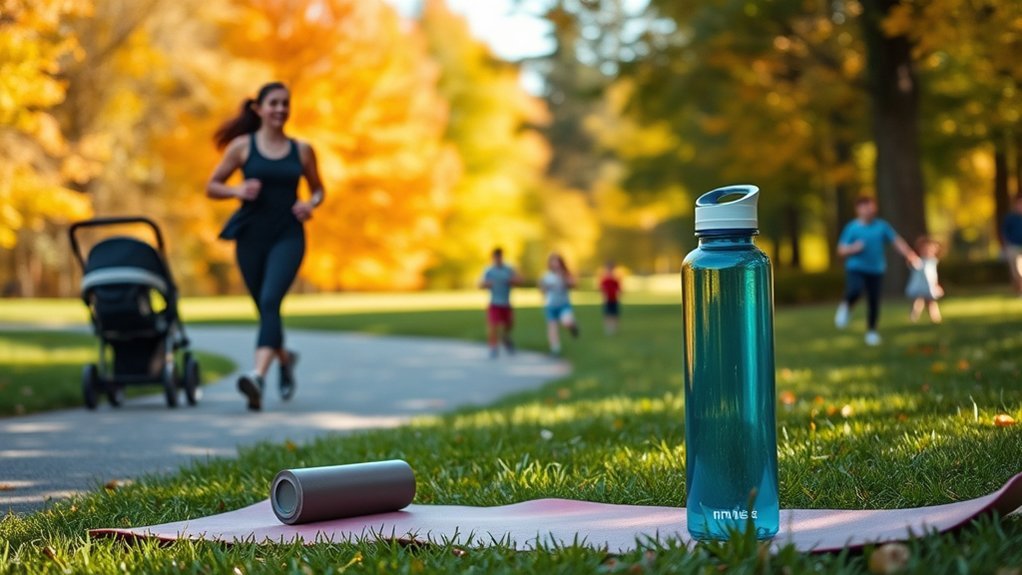As a parent, you play a vital role in shaping your child’s physical health. Understanding exercise guidelines can help you set appropriate activity levels for their age, ensuring they develop healthy habits. By incorporating fun physical activities into your daily routine, you not only promote fitness but also create lasting memories. Discover how these guidelines can transform your family’s approach to health and well-being, paving the way for a more active lifestyle together.
Understanding the Importance of Physical Activity

Understanding the importance of physical activity is essential for your child’s overall development, as it lays the foundation for a healthy lifestyle.
Regular exercise helps improve your child’s physical fitness, enhances motor skills, and boosts cognitive function. Research shows that active children are more likely to perform better academically and have improved concentration.
Regular exercise enhances physical fitness, motor skills, and cognitive function, leading to better academic performance and concentration in children.
Moreover, engaging in physical activities fosters social skills, teaching teamwork and cooperation. It also promotes emotional well-being by reducing anxiety and stress.
By encouraging your child to be active, you’re not just helping them build healthy habits; you’re also instilling confidence and resilience.
Prioritizing physical activity today sets the stage for a lifetime of health benefits, making it a crucial aspect of parenting.
Recommended Exercise Guidelines for Different Age Groups

To help your child reap the benefits of physical activity, it’s important to follow age-appropriate exercise guidelines. Here’s a quick overview of what’s recommended for different age groups:
| Age Group | Recommended Activity Duration | Type of Activities |
|---|---|---|
| 2-5 years | At least 3 hours daily | Active play, running, jumping |
| 6-17 years | 60 minutes daily | Sports, swimming, biking |
| 18-64 years | 150 minutes weekly | Aerobic exercises, strength training |
| 65 years and up | 150 minutes weekly | Walking, balance activities |
Encouraging your child to engage in these activities not only supports their physical health but also boosts their mental well-being, setting the foundation for a healthy lifestyle.
Fun Ways to Incorporate Exercise Into Daily Routines

Finding creative ways to weave exercise into your family’s daily routine can make staying active feel less like a chore and more like a fun adventure.
Start by turning chores into games—have a race to see who can clean their room the fastest or do jumping jacks while waiting for dinner to cook. Incorporate family walks or bike rides after meals; this not only aids digestion but also strengthens family bonds.
Consider active playdates where kids can run around at a local park. You can even set a family fitness challenge, tracking everyone’s progress and celebrating milestones together.
Balancing Screen Time and Physical Activity
Finding the right balance between screen time and physical activity is essential for your child’s health.
By setting clear limits on screen usage and encouraging active playtime, you can help foster a more active lifestyle.
Plus, engaging in family fitness activities together not only promotes exercise but also strengthens your family bond.
Setting Screen Time Limits
While screens can offer valuable educational content and entertainment, it’s important to set limits to make certain your child remains physically active. Establishing screen time guidelines helps balance their digital engagement with physical play. The American Academy of Pediatrics recommends no more than one hour of screen time for kids aged 2 to 5.
| Screen Time | Physical Activity |
|---|---|
| 2 hours/day | 1 hour of active play |
| 3 hours/day | 30 minutes of active play |
| 4 hours/day | 15 minutes of active play |
| Over 4 hours/day | No active play |
| Unlimited | Sedentary lifestyle |
Encouraging Active Playtime
To foster a balanced lifestyle for your child, prioritizing active playtime is key. Encouraging them to engage in physical activity helps develop motor skills, boosts mood, and promotes social interaction.
Aim for at least 60 minutes of active play each day, whether it’s riding bikes, playing tag, or dancing. Make it fun—incorporate games that involve running, jumping, or climbing.
Limit screen time to create more opportunities for physical activity; consider scheduling “screen-free” times during the day. Be a role model by showing enthusiasm for exercise yourself.
Research shows that children who see their parents being active are more likely to participate in physical activities. By fostering an environment that values play, you’ll set your child on a path to a healthier lifestyle.
Family Fitness Activities Together
Incorporating family fitness activities into your routine not only strengthens bonds but also sets a positive example for your children.
Balancing screen time with physical activity is essential for their development. Here are three engaging activities you can enjoy together:
- Family Walks or Biking: Choose scenic routes to explore your neighborhood or nearby parks. This promotes cardiovascular health while allowing for conversations and bonding.
- Outdoor Games: Play soccer, basketball, or frisbee in the yard or at a local field. These activities boost teamwork and coordination.
- Home Workouts: Create fun workout challenges or follow online fitness videos as a family. This promotes healthy habits and makes exercise enjoyable.
Setting a Positive Example as Active Parents
As you endeavor to create a healthy lifestyle for your family, remember that your actions speak louder than words.
Being an active parent not only benefits your health but also sets a powerful example for your children. When they see you engaging in physical activities—like jogging, biking, or playing sports—they’re more likely to mimic those behaviors.
Research shows that kids with active parents are 30% more likely to stay physically active themselves. Incorporate movement into your daily routine, whether it’s a family walk after dinner or a weekend hike.
Celebrate your achievements together, fostering a positive attitude towards fitness. By demonstrating your commitment to an active lifestyle, you empower your kids to make healthier choices as they grow.
Creating a Supportive Environment for Fitness
Creating a supportive environment for fitness is essential if you want your family to thrive physically and mentally.
By fostering a space that encourages activity, you can greatly impact your family’s well-being.
Here are three key ways to create that environment:
- Designate Active Spaces: Set aside areas in your home or yard for physical activities like dancing, yoga, or sports.
- Be Involved: Participate in activities together, whether it’s family walks, bike rides, or games. Your involvement makes exercise enjoyable.
- Promote Healthy Choices: Stock your kitchen with nutritious snacks and meals, making it easier for everyone to make healthier eating decisions.
Tracking Progress and Celebrating Achievements
Tracking progress and celebrating achievements can greatly boost your family’s motivation to stay active. Use a simple chart or app to record workouts, distance covered, or minutes spent exercising. This visual representation helps everyone see improvement over time, making fitness more tangible and rewarding.
Set achievable goals together—like completing a fun run or mastering a new sport. When you reach these milestones, celebrate! Whether it’s a special treat or a family outing, acknowledging success reinforces positive behavior.
Research shows that celebrating achievements increases adherence to fitness routines. So, make it a family tradition to celebrate. Not only does it foster a sense of accomplishment, but it also strengthens your family bond through shared experiences in health and fitness.
Frequently Asked Questions
What Are the Signs My Child Is Getting Enough Exercise?
You’ll know your child is getting enough exercise if they’re energetic, sleeping well, maintaining a healthy weight, and showing improved mood and focus. Regular participation in physical activities also boosts their social skills and confidence.
How Can I Motivate My Child to Be Active?
Inspire your child’s imagination by turning activities into fun adventures. Encourage team sports, family outings, or playful games. Celebrate their efforts, and they’ll associate movement with joy, making it a delightful part of their daily routine.
What if My Child Dislikes Traditional Sports?
If your child dislikes traditional sports, explore alternative activities like dance, hiking, or martial arts. Engaging in fun, non-competitive pursuits can spark their interest in movement and help them stay active in enjoyable ways.
Are There Specific Exercises for Children With Disabilities?
Yes, there are specific exercises for children with disabilities. Focus on adaptive activities like swimming, yoga, or modified team sports. Always consult a healthcare professional to tailor exercises to your child’s unique needs and abilities.
How Do I Handle My Child’s Exercise-Related Injuries?
You’ll find that handling your child’s exercise-related injuries isn’t as intimidating as it seems. First, assess the injury, seek medical advice, and guarantee proper rest and recovery. Don’t forget to encourage gentle, age-appropriate activities afterward!
Conclusion
Incorporating exercise into your family’s routine isn’t just beneficial; it’s a game-changer for your children’s health and happiness. By embracing these guidelines, you’ll not only boost their physical fitness, but you’ll also create lasting memories together. Remember, setting a positive example as active parents can ignite a lifelong passion for health that’s more powerful than a thousand motivational speeches. So, get moving and celebrate every little achievement on this exciting journey toward fitness and well-being!
